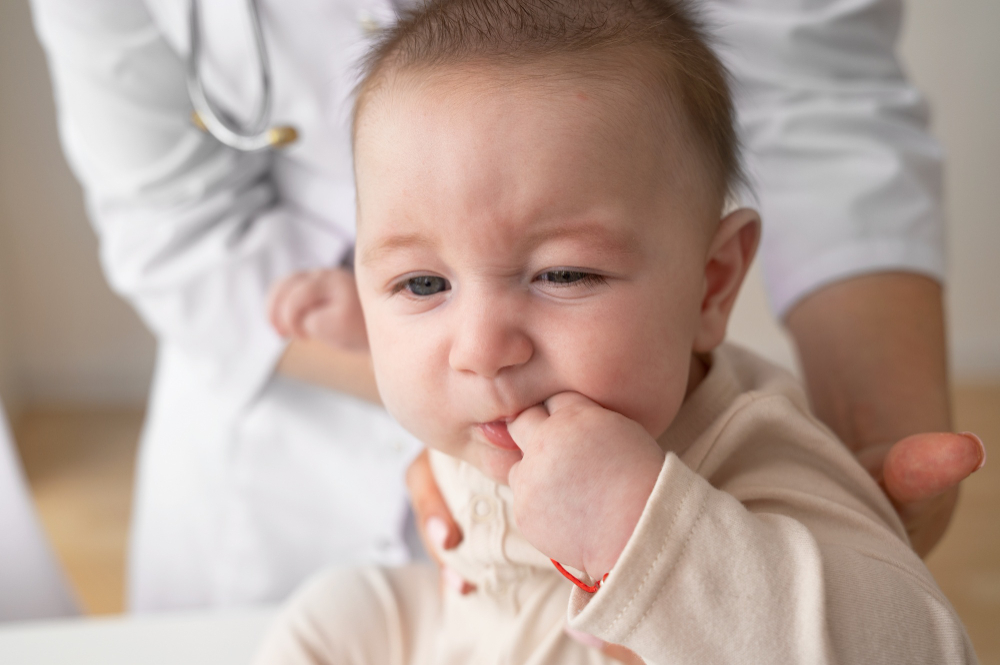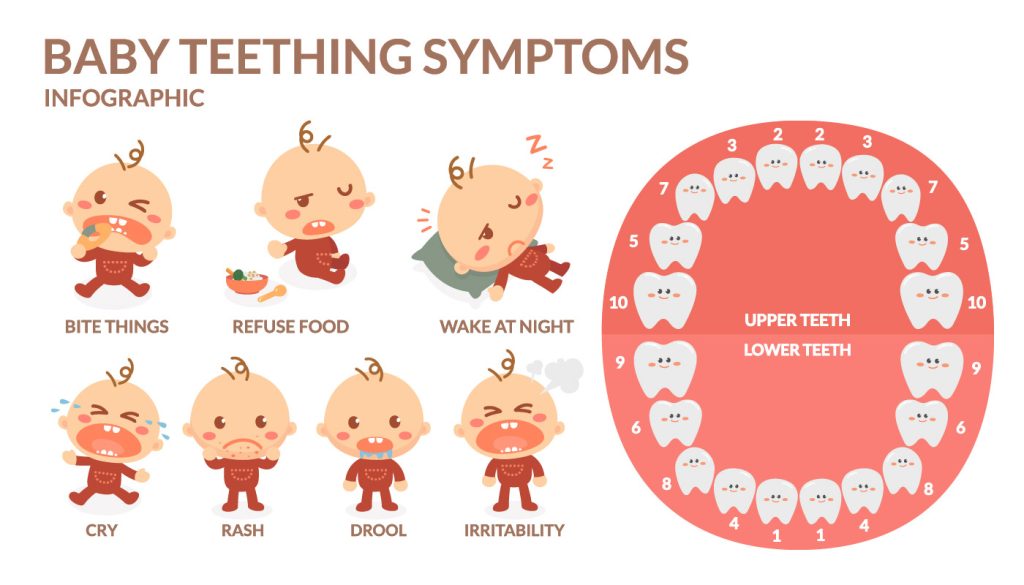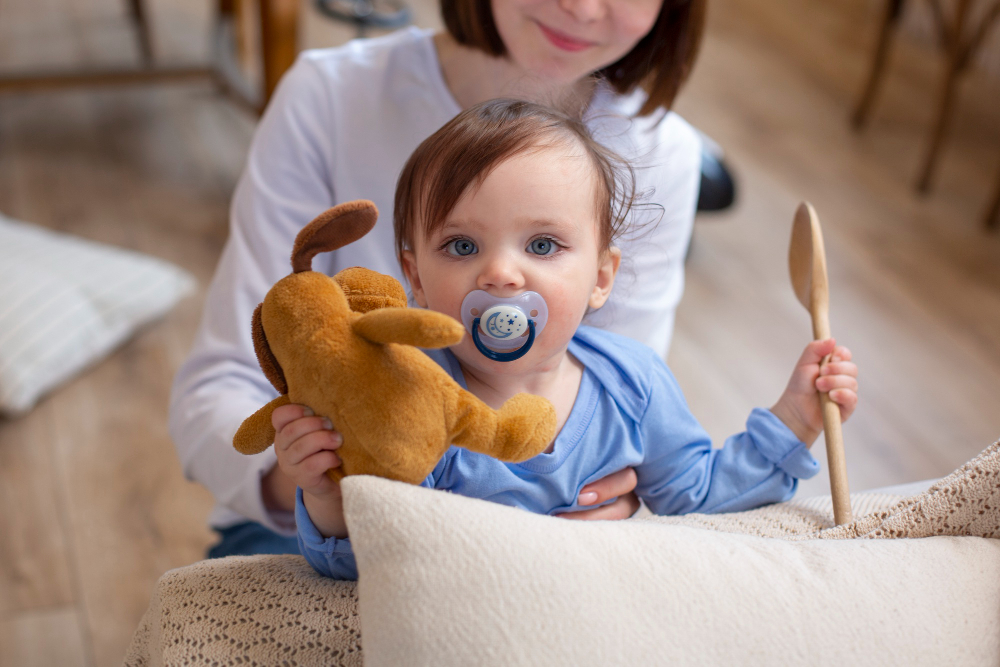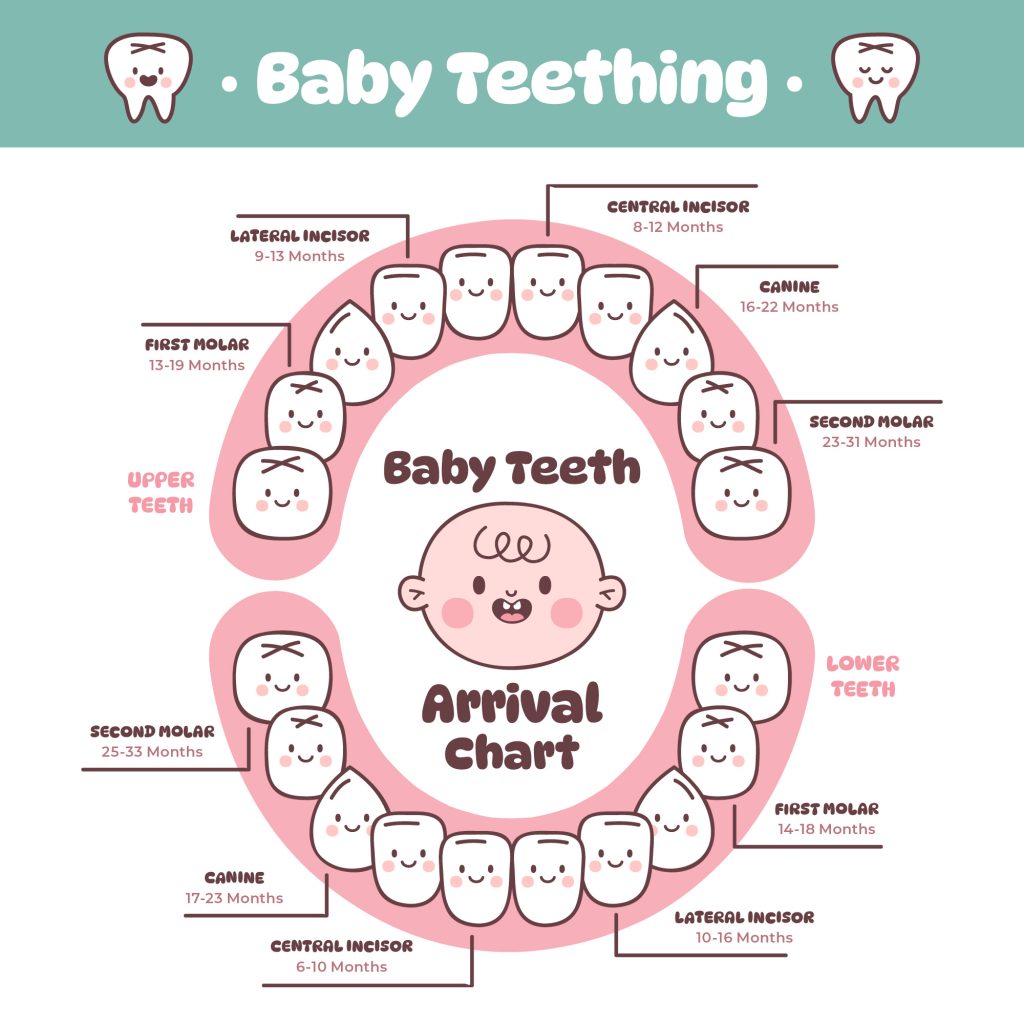Signs of Teething in Babies: Problems and Pain Relief
Are you a new parent who is wondering about signs of teething in babies? Is your baby in discomfort due to the same? Do you find yourself feeling helpless and wondering how to provide relief to your baby? Are you tired of seeing your little one fussy, drooling, and gnawing on everything in sight?
If you answered yes to any of these questions, then this blog is for you! As a parent, it can be tough to see your baby in distress during this natural developmental phase. But fret not! We’ve got you covered with expert advice, practical tips, and effective remedies to alleviate your baby’s teething discomfort.
So, sit tight and get ready to empower yourself on signs of teething in babies with knowledge and guidance to help your teething baby sail through this challenging phase with a smile.
Introduction to Teething in Babies

Teething is a natural and exciting milestone in a baby’s development that typically begins around six months of age. However, it can also be a challenging and uncomfortable time for both babies and parents. During the teething phase, babies may experience symptoms such as excessive drooling, irritability, swollen gums, and a strong urge to chew.
The purpose of this article is to provide a comprehensive guide to understanding the signs of teething in babies and offer expert tips and remedies to ease their discomfort.
It is important to note that every baby is unique, and their teething experience may vary. While some babies may go through teething with minimal discomfort, others may experience more pronounced symptoms.
As a parent, it can be distressing to see your little one in discomfort. However, being aware of the signs and symptoms of teething can help you provide the necessary support and comfort to your baby during this time. In the following sections, we will explore when teething typically begins, how to recognize the signs of teething, effective methods to soothe your teething baby, and when to seek medical attention.
Remember, the teething phase is temporary, and soon enough, your baby will have a beautiful set of teeth to flash their adorable smile. Let’s dive into the world of teething and learn how to make this journey as comfortable as possible for your little one.
When Does Teething Begin for Infants?

Teething is a milestone in a baby’s development that occurs when their primary teeth, also known as baby teeth, start to emerge through their gums. While it is difficult to pinpoint an exact timeframe, teething typically begins around six months of age. However, it’s important to note that every baby is different, and some may start teething earlier or later than others.
During the teething process, the baby’s gums may become swollen and sensitive, causing discomfort and irritability. They may also experience increased drooling and a strong urge to chew on various objects. These symptoms can be challenging for both babies and parents, but there are ways to alleviate the discomfort and provide relief.
It’s important to remember that teething is a gradual process, and it can take several months for a tooth to fully emerge. The order in which the teeth come in can also vary from one baby to another, but typically the bottom front teeth, also known as the central incisors, are the first to make an appearance. They are followed by the top front teeth, then the molars, and finally the canines.
If your baby hasn’t started teething by the age of one, it’s advisable to consult a pediatric dentist for a thorough examination. They can provide guidance and ensure that your baby’s dental development is on track.
In conclusion, teething usually begins around six months of age, but every baby is unique, and the timing can vary. It’s essential to be patient and provide comfort to your little one during this potentially uncomfortable phase.
Recognizing the 7 Common Signs of Teething in Babies

Teething can be a challenging time for both babies and parents. It’s important to be able to recognize the common signs and symptoms of teething so that you can provide appropriate care and relief for your little one. Here are some signs to watch out for:
1. Drooling
Excessive drooling is a common sign of teething. Your baby may have a constantly wet chin and may even develop a facial rash as a result.
2. Skin rashes
Teething can cause skin rashes around your baby’s mouth and chin due to the excess saliva. Keep the area clean and dry to minimize any irritation.
3. Coughing
The increased drooling may also lead to a cough. If your baby experiences a persistent cough without any other signs of illness, it could be a result of teething.
4. Biting
Babies often find relief by biting on objects during the teething process. They may chew on their hands, toys, or even your fingers to soothe their gums.
5. Low-grade fever
While teething itself doesn’t cause a high fever, a slight increase in body temperature (not more than 100.4 degrees Fahrenheit) is common. If your baby has a high fever, consult their pediatrician.
6. Cheek rubbing
If your baby rubs their cheeks frequently, it could indicate teething discomfort. Gently massage their cheeks to provide some relief.
7. Ear pulling
Teething pain can sometimes radiate to the ears, leading to your baby tugging at their ears. It’s important to rule out any other ear-related issues if the pulling persists.
Keep in mind that every baby is different, and not all of these signs of teething in babies may be present. It’s also possible for your baby to exhibit some of these signs without teething.
However, if your baby is experiencing several of these symptoms together, it’s likely that teething is the cause. Remember to consult your pediatrician if you have any concerns about signs of teething in your baby or if your baby’s discomfort persists.
4 Handy Tips to Soothe a Teething Baby

When your baby is going through the teething phase, providing relief and soothing their discomfort becomes a top priority. Here are some effective remedies and measures that can help ease their teething pain:
1. Teething Toys
Give your baby safe and age-appropriate teething toys to chew on. These toys provide gentle pressure and can help soothe their sore gums.
2. Cold Temperatures
Cold can provide temporary relief to teething babies. You can give them a chilled teething ring or a clean, damp washcloth placed in the refrigerator for a short while. Avoid freezing the toys or using ice, as extreme cold can be too harsh for their delicate gums.
3. Pain Relievers (if advised by a pediatrician)
In some cases, if the pain and discomfort are severe, a pediatrician may recommend over-the-counter pain relievers specifically designed for infants. Always consult with a healthcare professional before giving any medication to your baby.
4. Massage Techniques
Gently massaging your baby’s gums with a clean finger or a non-sugar-coated teething ring can alleviate some of their discomfort. Ensure that your hands are clean before proceeding.
Remember, every baby is different, and what works for one may not work for another. It’s essential to pay attention to your baby’s cues and find the methods that bring them the most comfort. Additionally, be sure to monitor their teething progress closely and seek medical advice if you have any concerns or if their teething symptoms persist or worsen.
Caring for a teething baby can be challenging, but with these tips, you can help ease their discomfort and provide them with much-needed relief.
Order of Tooth Eruption

Baby teeth, also known as primary teeth or milk teeth, typically start erupting between the ages of 6 to 10 months. However, it’s important to note that the timing can vary from child to child. The order in which baby teeth come in is generally consistent, although there may be slight variations.
- The eruption process usually begins with the two bottom front teeth, known as the lower central incisors.
- They are followed by the two top front teeth, known as the upper central incisors. These are the first teeth that your baby will show off when they smile.
- Next, the lateral incisors, which are located on either side of the central incisors, start to make their appearance.
- These are followed by the first molars, which are larger teeth located at the back of the mouth.
- After the first molars, the canines or “fang” teeth emerge. These are the pointy teeth located next to the lateral incisors.
- Finally, the second molars, which are larger than the first molars, complete the set of baby teeth.
It’s important to remember that the timing and order of tooth eruption can vary. Some children may experience a slightly different sequence, but it is generally a good guideline to follow. If you have any concerns about the eruption of your baby’s teeth, it’s always a good idea to consult with a pediatric dentist for guidance.
Remember to regularly care for your baby’s teeth by gently cleaning them with a clean finger or a soft cloth. As the teething process progresses, you can introduce a soft-bristled toothbrush and a small amount of fluoride toothpaste (about the size of a grain of rice) to maintain good oral hygiene.
Teething Treatments to Avoid
When your baby is going through the uncomfortable teething phase, it’s natural to want to provide them with relief. However, it’s essential to be aware of the teething remedies that should be avoided due to safety risks or their ineffectiveness. Here are some common teething treatments that experts advise against:
1. Teething Gels Containing Benzocaine
Benzocaine, a numbing agent commonly found in teething gels, can be harmful to infants. The U.S. Food and Drug Administration (FDA) warns against using products with benzocaine on children under two years old due to the risk of a rare but potentially life-threatening condition called methemoglobinemia.
2. Herbal Teething Remedies
While natural remedies may seem appealing, it’s crucial to exercise caution. Some herbal teething remedies may contain ingredients that can be harmful to babies, such as alcohol or high levels of certain herbs. Always consult with a pediatrician before using any herbal products.
3. Amber Teething Necklaces
Amber teething necklaces gained popularity for their supposed teething-relief properties. However, there is no scientific evidence to support their effectiveness. Additionally, there is a risk of choking or strangulation if the necklace breaks or if the baby pulls it tightly around their neck.
4. Teething Tablets
Some teething tablets may contain homeopathic remedies that have not been proven effective and could potentially cause adverse reactions. It’s best to consult with a healthcare professional before using any oral homeopathic remedies.
5. Frozen Foods or Liquids in Mesh Feeders
While providing cool relief can be helpful, placing frozen foods or liquids in mesh feeders can pose a choking hazard. Opt for safer alternatives such as chilled teething rings or clean, wet washcloths.
Remember, the safety and well-being of your baby should always be the top priority. If you have any concerns about your baby’s teething symptoms or remedies, it’s important to consult with a healthcare professional for guidance.
When to Seek Medical Attention: Signs of Teething in Babies

Teething is a normal developmental stage that most infants experience, but there are times when it is necessary to seek medical attention for your teething baby. While teething discomfort can cause mild symptoms such as drooling, irritability, and mild temperature, there are certain signs that indicate a need for professional evaluation. Here are some situations where seeking medical advice is recommended:
Persistent High Fever
If your baby develops a high fever (above 101 degrees Fahrenheit) that lasts longer than 24 hours and is not accompanied by any other signs of illness, it is important to consult a healthcare professional. Teething usually does not cause a high fever, so it’s essential to rule out any other underlying medical condition.
Excessive Vomiting or Diarrhea
While a slight increase in drooling is normal during teething, excessive vomiting or diarrhea is not typically associated with teething. If your baby experiences severe or persistent vomiting or diarrhea, it is advisable to seek medical attention to rule out other causes.
Severe Oral Infection or Swelling
Teething can lead to some mild irritation and redness in the gums, but if you notice severe oral infection, significant swelling, or abscess formation, it is crucial to consult a healthcare professional. These symptoms may indicate a more serious oral health issue that requires immediate attention.
Difficulty Eating or Breathing
If your baby has difficulty eating, swallowing, or shows signs of respiratory distress while teething, it is recommended to seek medical advice promptly. These symptoms could indicate an unrelated medical problem that needs evaluation and treatment.
Remember, as a parent, it’s important to trust your instincts. If you have any concerns about your teething baby’s health, always consult a healthcare professional for a proper diagnosis and appropriate guidance.
FAQs: Signs of Teething in Babies
Q: What are the signs of teething in babies?
A: The signs of teething in babies include excessive drooling, irritability, swollen gums, and a strong urge to chew.
Q: At what age does teething begin for infants?
A: Teething typically begins around six months of age, but every baby is unique, and the timing can vary.
Q: How long does teething last in babies?
A: Teething can last several months, and it can take several months for a tooth to fully emerge.
Q: How can I soothe my teething baby?
A: You can soothe your teething baby by providing a clean, cold object to chew on, massaging their gums with a clean finger, or giving them a gentle gum massage with a cold, damp washcloth.
Q: Can teething cause a fever in babies?
A: While teething itself doesn’t cause a high fever, a slight increase in body temperature (not more than 100.4 degrees Fahrenheit) is common. If your baby has a high fever, consult their pediatrician.
Q: Is it normal for my baby to have a cough during teething?
A: The increased drooling during teething may also lead to a cough. If your baby experiences a persistent cough without any other signs of illness, it could be a result of teething.
Q: When should I seek medical attention for my teething baby?
A: If your baby has a high fever, diarrhea, vomiting, or a rash, or if you notice any other unusual symptoms, it’s important to seek medical attention to rule out any other underlying health issues.
The Final Note: Signs of Teething in Babies
To sum up, teething can be a challenging and uncomfortable time for both babies and parents. However, being aware of the signs and symptoms of teething can help you provide the necessary support and comfort to your baby during this time.
We hope this comprehensive guide to understanding the signs of teething in babies and expert tips and remedies to ease their discomfort have been helpful to you as a new parent.
Remember, every baby is unique, and their teething experience may vary. Be patient and provide comfort to your little one during this potentially uncomfortable phase. And if you have any concerns or questions about your baby’s teething, don’t hesitate to consult with your pediatrician or a pediatric dentist.
Finally, thank you for reading our blog on signs of teething in babies. We hope it has empowered you with knowledge and guidance to help your teething baby sail through this challenging phase with a smile. If you found this blog helpful, please share it with other parents who may benefit from it.







